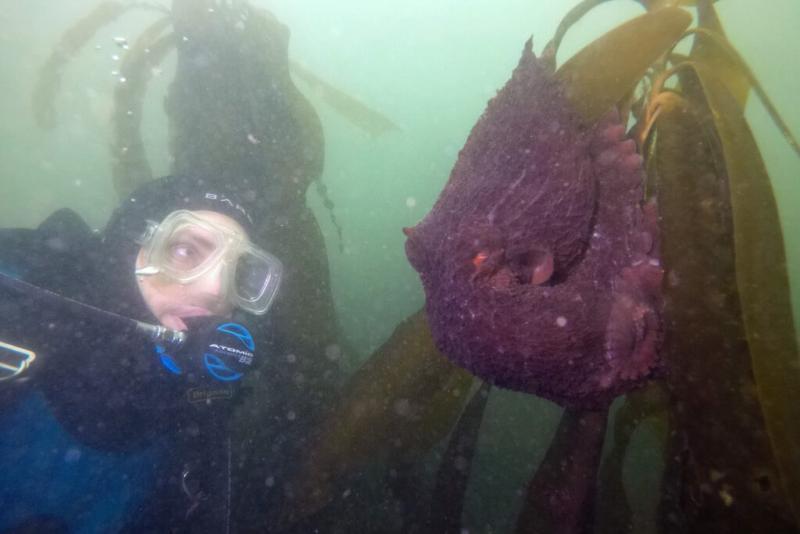
California Current ecosystem shows resilience to strong El Niño
by NOAA Fisheries 19 Mar 2024 18:12 UTC

NOAA divers conducting annual 2023 underwater kelp forest surveys in Olympic Coast National Marine Sanctuary © Steve Lonhart, NOAA
The 2023-2024 California Current Ecosystem Status Report shows an abundance of forage fish and a productive system fueled by upwelling.
The California Current ecosystem is a vital ocean system stretching from Washington to Baja California. It is facing a strong 2024 El Niño event, a cyclical warming of the Pacific Ocean. However, the latest information from NOAA’s Integrated Ecosystem Assessment program suggests the ecosystem is better positioned to weather these changing conditions than previous El Niño events.
A Year of Mixed Conditions
The annual California Current Ecosystem Status Reports compile results from researchers who monitor changes and trends in all facets of ecosystem health. They represent physical, chemical, biological, and socio-economic sciences. Results from these reports are presented annually to the Pacific Fishery Management Council.
The California Current ecosystem experienced both positive and negative conditions from the coast to the offshore waters in 2023. On land, atmospheric rivers produced extreme precipitation events in early 2023. This resulted in a record mountain snowpack and reduced longstanding drought conditions for some regions. Additionally, the fourth largest marine heatwave was recorded in offshore waters during the summer. It contributed to an overall warming trend of ocean waters over recent years. Offshore marine heatwaves have occurred annually since the historic heatwave in 2013 called "The Blob."
Mixed environmental conditions resulted in mixed responses by marine organisms. The report identified an abundance of anchovies and juvenile groundfish, like rockfish, off California. There was also an abundance of tiny crustaceans flush with nutritious lipids off Oregon. They provide a diverse prey base for species from salmon to whales. There was also a positive trend in seabird numbers, which reflects productive ocean conditions. Waters rich in nutrients from strong, fleeting coastal upwelling events, mixed with warm ocean waters, produced intense harmful algal blooms. They caused multiple shellfish fishery closures and marine mammal strandings along the Pacific coast.
El Niño's Past Impacts
During 2023, Pacific Ocean temperatures around the equator shifted from cool La Niña conditions into warm “strong” El Niño conditions by the autumn and winter months. These changes in Pacific Ocean temperatures impact regional and local conditions across multiple countries, including the United States.
The last strong El Niño, in 2015, coincided with the tail end of a massive marine heatwave that had already weakened the ecosystem. This "double whammy" led to cascading effects, harming numerous species. For example, starving sea lion pups arrived on Southern California beaches while their mothers were gone foraging for prey. The prey had shifted farther away in search of cooler, more nutrient-rich waters.
A Resilient Ecosystem
This time around, the story seems different. The 2023-24 California Current Ecosystem Status Report reveals a more robust ecosystem in what we're forecasting as a short-lived El Niño period.
"The difference is that the system was already compromised when the last El Nino arrived," said Andrew Leising, research oceanographer at NOAA Fisheries Southwest Fisheries Science Center. "This time, the ecosystem is in pretty good shape going into El Niño, so it should have more resilience to get through it."
Leising explains that despite tracking the fourth-largest marine heatwave in 2023, we did not observe the same ecological impacts as the original marine heatwave. That's because the heat did not penetrate as deep, and upwelling along the coast helped hold the marine heatwave farther offshore.
The overall message from the report is one of cautious optimism. The California Current ecosystem entered the current El Niño in a stronger state than in 2015. In 2023, the California Current ecosystem had a strong, diverse prey base, and positive indicators for many species. Because of that and a forecasted rapid return to cooler conditions, we are optimistic the ecosystem will be resilient to the coming changes in 2024.
Results from annual Ecosystem Status Reports highlight the importance of continued long-term monitoring, research, and management efforts to understand the changing ecosystem and how it may affect our fisheries and the coastal communities that depend on them.